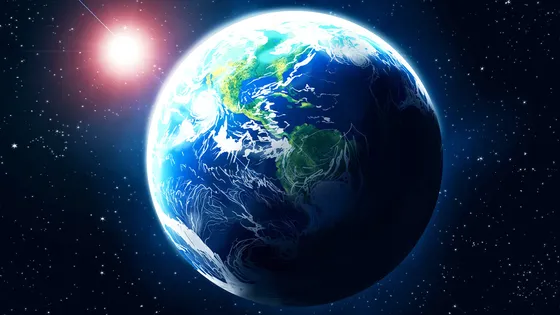
In the global community, Earth is better known as Terra – the third planet in our star system and the only one that can support life. The Earth has created ideal climatic conditions for people and animals – this is our home, which we must take care of.
Earth is a fairly young planet that became suitable for human life on Earth only 60 million years ago. Since then, it has given shelter to many human civilizations, about which only echoes have reached us in the form of legends and unique buildings. Some left the Earth, some were destroyed during the cataclysms. Now the fate of the Earth is in great doubt.
We know that life on Earth follows certain rhythms or cycles. Most of us know only two such cycles – day/night and the cycle of the seasons. However, studying the Earth's past shows that there are other longer cycles that manifest themselves in various climatic changes on the planet.
The most interesting is the 12,000-year cycle of geomagnetic excursions, that is, a significant weakening of the Earth's magnetic field. The magnetic field is produced by the core of the planet and every 12,000 years, something affects the core so much that the magnetic field weakens by about 10 times its normal value. And then, a relatively short phase of global climate disasters begins, lasting only 20-30 years, and accompanied by catastrophic climate changes: multiple eruptions, including supervolcanoes, extensive fires, huge tsunamis, movements of tectonic plates and other cataclysms.

Traces of these 12,000-year periods of catastrophes have been found in various ice cores from different glaciers of the Earth, as well as in the history of soil stratifications throughout the planet.
Every 24,000 years, the catastrophe phase manifests itself much more vividly, and is accompanied by the obligatory eruption of some supervolcano or even several with atmospheric pollution by volcanic ash, followed by cooling and glaciation. Obviously, this made life on Earth almost impossible and each time led to a large-scale death of flora, fauna and human communities.
Unfortunately, the Earth is now at the end of a 24,000-year cycle and, as we can see, has already entered a phase of catastrophes. We are at the very beginning of it, but we already see all the signs: instability of the earth's core, a sharp weakening of the magnetic field, an exponential increase in the number and strength of earthquakes, warming of the planet's interior and, as a result, warming of the oceans and atmosphere, increased wind strength, the appearance of prolonged and very powerful hurricanes, typhoons, saturation of the atmosphere with water vapor and, as a result, multiple floods.
In this 24,000-year cycle, the catastrophe phase can destroy not only all life on Earth, but also the planet itself. As it was with our neighbor Mars. Because we humans have destroyed the Earth's defense systems – ecology. Especially the oceans – they should be much more efficient at removing excess heat into the atmosphere and space, but the thermal conductivity of the oceans has greatly decreased due to pollution of ocean waters with micro and nano plastics and other petroleum products. As a result, heat accumulates more, rather than being discharged. Because of this, the oceans evaporate more actively, and the greenhouse effect increases. We humans really broke it, and because of us, the Life of the Earth is under threat.
Earth is a beautiful planet. It is urgently necessary to unite and look for ways for all mankind to save her. And myself at the same time.